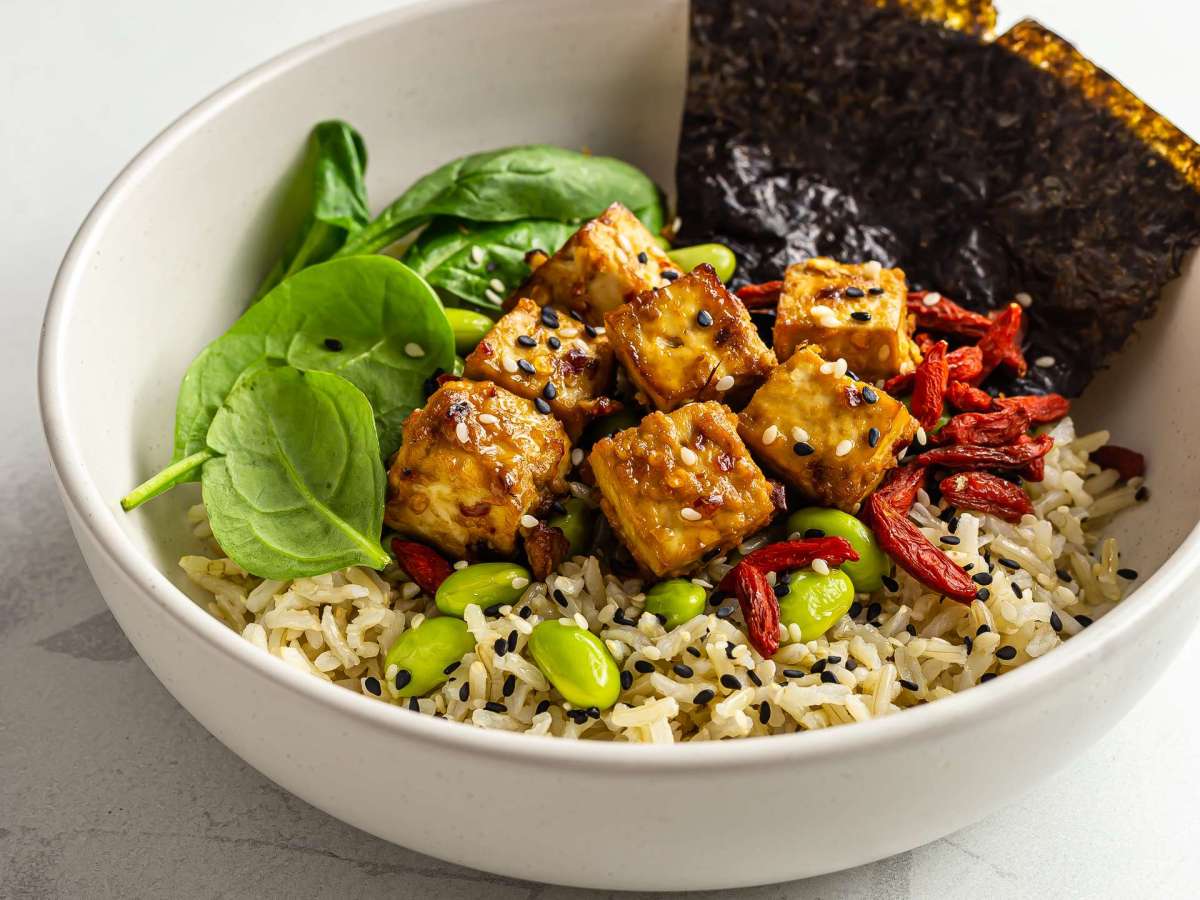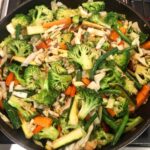Embark on a culinary adventure beyond the familiar tofu and soy staples! This exploration unveils a vibrant world of protein-packed vegan recipes, showcasing the surprising versatility of ingredients often overlooked. Imagine vibrant colors, textures that tantalize the palate, and flavors that dance on your tongue – all without relying on the usual suspects. Prepare to discover a new level of creativity and satisfaction in your plant-based diet.
We’ll delve into a collection of innovative main courses, sides, starters, snacks, and even desserts, each brimming with plant-based protein. Learn about the nutritional powerhouses you can use to build a complete and satisfying vegan meal plan, avoiding potential nutritional gaps often associated with restrictive diets. Get ready to expand your culinary horizons and experience the delicious possibilities of a tofu- and soy-free vegan lifestyle.
Recipe Ideas


This section explores three delicious vegan recipes—two side dishes and one starter—all thoughtfully crafted without tofu or soy, showcasing vibrant flavors and textures. These recipes are designed to be both satisfying and adaptable, easily incorporated into a variety of meal plans. The emphasis is on creative flavor combinations and accessible ingredients.
Roasted Sweet Potato and Chickpea Salad with Harissa Dressing
This vibrant side dish offers a delightful blend of sweet and spicy flavors. The roasted sweet potatoes provide a natural sweetness, complemented by the earthy chickpeas and the fiery kick of the harissa paste. The contrasting textures—tender sweet potatoes, firm chickpeas, and crunchy toasted pecans—create a multi-sensory experience. This salad pairs well with grilled vegetables, hearty grain bowls, or as a side to flavorful lentil stews.
- Preheat oven to 400°F (200°C). Cube 1 large sweet potato and toss with 1 tbsp olive oil, salt, and pepper. Roast for 20-25 minutes, or until tender.
- While sweet potatoes roast, drain and rinse 1 can (15oz) chickpeas. In a small bowl, whisk together 2 tbsp harissa paste, 1 tbsp olive oil, 1 tbsp lemon juice, and a pinch of salt.
- Combine roasted sweet potatoes and chickpeas in a large bowl. Pour harissa dressing over the mixture and toss gently to coat. Stir in ¼ cup chopped pecans (optional).
- Serve warm or at room temperature.
Garlic and Herb Roasted Broccoli with Lemon
This simple yet elegant side dish highlights the natural flavor of broccoli, enhanced by the aromatic garlic and herbs. Roasting intensifies the broccoli’s flavor and creates a slightly caramelized exterior. The bright lemon juice cuts through the richness of the garlic and herbs, adding a refreshing touch. This side dish is versatile, complementing a range of main courses from rich pasta dishes to lighter fish or poultry options (when including a non-vegan option).
- Preheat oven to 400°F (200°C). Cut 1 large head of broccoli into florets.
- In a large bowl, toss broccoli florets with 2 tbsp olive oil, 2 cloves minced garlic, 1 tbsp chopped fresh herbs (rosemary, thyme, or oregano), salt, and pepper.
- Spread broccoli in a single layer on a baking sheet. Roast for 15-20 minutes, or until tender-crisp.
- Before serving, squeeze the juice of ½ lemon over the roasted broccoli and toss gently.
Flavor Profile Comparison
The sweet potato and chickpea salad offers a sweeter, spicier profile, while the garlic and herb roasted broccoli provides a more savory, herbaceous taste. The sweet potato salad’s vibrant flavors make it an excellent complement to dishes with earthy or savory notes, such as lentil stews or roasted vegetables. Conversely, the garlic and herb roasted broccoli’s milder flavor allows it to pair well with a broader range of dishes, from rich pasta sauces to lighter fare.
Spicy Peanut Noodles with Crispy Vegetables
This vibrant starter showcases a delightful interplay of textures and flavors. The peanut sauce provides a creamy, nutty base, while the crispy vegetables add a satisfying crunch. The chili garlic sauce adds a subtle heat, balancing the richness of the peanut butter. The preparation process involves several steps, highlighting key techniques like properly blanching vegetables to retain their vibrant color and crisp texture.
- Blanching the Vegetables: Begin by preparing your vegetables. Imagine vibrant strips of bell peppers (red and yellow), crisp broccoli florets, and slender carrot batons. Bring a pot of salted water to a boil. Add the vegetables and blanch for about 2 minutes until slightly softened but still crisp. Immediately transfer to an ice bath to stop the cooking process and maintain their vibrant color. The vegetables should retain their bright hues and a pleasant snap.
- Preparing the Peanut Sauce: In a separate bowl, whisk together 2 tablespoons of creamy peanut butter (ensure it’s free of soy lecithin), 1 tablespoon of rice vinegar, 1 tablespoon of soy-free tamari (or coconut aminos), 1 teaspoon of sesame oil, ½ teaspoon of chili garlic sauce, and a pinch of salt. The sauce should be smooth and emulsified, with a harmonious balance of sweet, savory, and spicy notes.
- Combining and Serving: Gently toss the blanched vegetables with the peanut sauce, ensuring they are evenly coated. The vegetables should be glistening with the sauce, their colors intensified. Serve immediately, garnished with chopped peanuts and fresh cilantro for added texture and aroma. The final dish is a visual delight, with the vibrant colors of the vegetables contrasting beautifully with the creamy peanut sauce.
Recipe Ideas


Creating delicious and satisfying vegan snacks and desserts without relying on tofu or soy can present a unique challenge, but it’s entirely achievable with a little creativity and the right ingredients. The following recipes highlight the versatility of plant-based protein sources like nuts, seeds, and legumes, showcasing their ability to deliver both rich flavor and substantial protein content. These recipes are designed to be both enjoyable and nutritious, offering a guilt-free indulgence.
High-Protein Vegan Snacks and Desserts
The absence of tofu and soy opens up opportunities to explore diverse flavor profiles and textures. The following recipes demonstrate how to leverage alternative protein sources to create delectable treats. Each recipe provides a good source of protein, contributing to a balanced and satisfying diet.
- Peanut Butter and Hemp Seed Energy Bites: These no-bake bites are packed with protein from peanut butter and hemp seeds, offering a quick and easy snack. Imagine rich, earthy peanut butter mingling with the slightly nutty taste of hemp seeds, all bound together into perfectly portable bites. The texture is wonderfully chewy and satisfying. View Recipe
- Black Bean Brownies: These fudgy brownies surprise with their intense chocolate flavor and surprisingly moist texture, all while delivering a significant protein boost from black beans. Picture a deep, dark brownie, almost intensely chocolatey, with a subtly sweet and slightly earthy undertone from the black beans. The texture is wonderfully dense and fudgy, melting in your mouth. View Recipe
- Pumpkin Seed and Quinoa Protein Pudding: This creamy pudding boasts a subtly sweet flavor and a smooth, luxurious texture, thanks to the combination of pumpkin seeds and quinoa. Envision a vibrant orange pudding, with flecks of green quinoa adding visual interest. The texture is incredibly smooth and creamy, almost like a silken dessert. The flavor is subtly sweet, with a pleasant nutty undertone from the pumpkin seeds. View Recipe
Challenges and Solutions in High-Protein Vegan Dessert Creation (Without Tofu or Soy)
One of the primary challenges in creating high-protein vegan desserts without tofu or soy is achieving a desirable texture and avoiding a dry or crumbly final product. Soy and tofu often contribute to the creaminess and moisture of vegan desserts. However, this can be overcome by strategically incorporating other ingredients. For instance, using pureed fruits like pumpkin or sweet potato adds moisture and natural sweetness. Nut butters, such as almond or cashew butter, contribute both protein and a creamy texture. Additionally, incorporating ingredients like chia seeds or flax seeds, which absorb liquid and create a gel-like consistency, can help to bind ingredients and enhance moisture retention. Careful attention to the ratio of wet to dry ingredients is crucial to achieving the desired texture. For example, adding too much flour might lead to a dry dessert, while too much liquid can result in a runny one. Experimentation and careful recipe adjustments are key to success.
From hearty main courses bursting with flavor to delightful desserts that satisfy your sweet tooth, this journey into the world of tofu- and soy-free vegan cooking proves that delicious and nutritious plant-based meals are abundant and endlessly creative. The key lies in exploring the diverse range of protein-rich ingredients nature provides, allowing you to craft exciting and satisfying meals tailored to your preferences. So, embrace the challenge, experiment with new flavors and textures, and savor the incredible taste of a vibrant, protein-packed vegan diet.
Question Bank
What are some common nutritional concerns when avoiding soy and tofu?
Eliminating soy and tofu can reduce intake of iron, calcium, and certain B vitamins. Careful planning with diverse alternatives is crucial.
Are there any specific challenges in creating high-protein vegan desserts without soy or tofu?
Yes, achieving creamy textures and richness without soy milk or tofu can be tricky. Consider using alternatives like cashew cream, avocado, or silken coconut milk.
How can I ensure I’m getting enough protein on a tofu- and soy-free vegan diet?
Prioritize a variety of protein sources like lentils, quinoa, chickpeas, hemp seeds, and nuts. Combining different protein sources in meals maximizes amino acid absorption.


